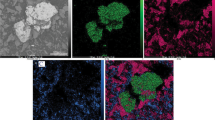Abstract
The oxidation behavior in air at 1473 K, and sulfidation behavior in a H2S–H2 gas mixture with a sulfur partial pressure of 10−2 Pa at 973 K of Al–Re coated CMSX-4 were studied. Investigation on the sulfidation behavior of the Re-coated CMSX-4 was carried out in a H2S–H2 gas mixture with a sulfur partial pressure of 10−2 Pa at 973 K. The experimental results show that a Re-rich alloy layer was formed between an α-Al2O3 layer and the inner concentration zone of Ta and Ti for the CMSX-4 single crystal alloy with an Al–Re coating after oxidation. The Re-rich alloy layer containing Cr, W, Ni, Co, and Mo effectively inhibited the outward diffusion of alloying elements and the inward diffusion of Al. The Al/Re-coated CMSX-4 single crystal alloy had excellent sulfidation resistance; the Re-rich alloy layer, containing W, Ti, Ta, and Mo, which formed during the sulfidation process and located between the alumina scale and the CMSX-4 base alloy, plays a role in inhibiting the outward diffusion of alloying elements. The sulfidation resistance of CMSX-4 single-crystal alloy is greatly improved by a Re coating on the CMSX-4 alloy surface; this is attributed to a Re–Cr–W alloy layer that retarded the outward diffusion of cations and the oxide layer containing Ta, Ti, and Al, which inhibited the inward penetration of sulfur.
Similar content being viewed by others
References
P. L. Daniel and R. A. Ropp, in Advances in Corrosion Science and Technology, Vol. 5, M. G. Fontana and R. Ataehle, eds. (Plenum Press, New York 1976), p. 55.
H. J. Lim, S. W. Park, and S. G. Kang, Oxid. Met. 48, 391 (1997).
M. J. McNallan, Y. Y. Lee, Y. W. Chang, N. S. Jacobison, and J. Doychak, J. Electrochem. Soc. 138, 3692 (1991).
C. A. Rau, Jr., A. E. Gemma, and G. R. Leverant, Fatigue at Elevated Temperatures, ASTM STP 520 (ASTM, Philadelphia, PA, 1973), p. 166.
F. L. VerSnyder and M. E. Shank, Mater. Sci. Eng. 6, 231 (1970).
T. Narita, T. Ishikawa, and K. Nishida, Oxid. Met. 27, 221 (1987).
T. Narita, T. Ishikawa, and K. Nishida, Oxid. Met. 27, 239 (1987).
D. J. Young, W. W. Smeltzer, and J. S. Kirkaldy, J. Electrochem. Soc. 120, 1221 (1973).
W. Kai and D. L. Douglass, Oxid. Met. 39, 281 (1993).
Y. Niu, F. Gesmundo, and F. Viani, Corros. Sci. 36, 1993 (1994).
M. Schültz, A. Rahmel, and M. Schiitze, Oxid. Met. 49, 33 (1998).
A. I. Rybnikov and L. B. Getsov, Mater. High Temp. 13, 125 (1995).
T. S. Hussey, M. J. Koczak, R. W. Smith, and S. R. Kalidindi, Mater. Sci. Eng. A229, 137 (1997).
E. Lang ed., Coating for High Temperature Applications (Elsevier, New York, 1983), p. 33.
M. W. Cook, P. K. Bossom, Intern. J. Refractory Met. Hard Mater. 18, 147 (2000).
S. Chevalier, P. Dufour, G. Bonnet, and J. C. Colson, Oxid. Met. 50, 271 (1998).
Z. M. Yu, K. Inagawa, and Z. J. Jin, Surf. Coatings Technol. 70, 147 (1994).
C. S. McDowell and S. N. Basu, Oxid. Met. 43, 263 (1995).
Z. M. Yu, K. Inagawa, and Z. J. Jin, Thin Solid Films, 264, 52 (1995).
G. L. Erickson, Superalloys 1996, R. D. Kissinger et al., eds. (TMS, Warrendale, PA, 1996), p. 35.
D. Blavette, P. Caron, and T. Khan, Superalloys 1988, D. N. Duhl et al., eds. (TMS, Warrendale, 1988), p. 305.
R. N. Nabarro, Metall. Mater. Trans. 27A, 513 (1996).
K. Inagawa, K. Watanabe, I. Tanaka, and A. Itoh, J. Nucl. Mater. 128, 925 (1984).
K. L. Mittal (ed.), Adhesion Measurement of Thin Films, Thick Films and Bulk Coatings (ASTM, Philadelphia, PA, 1978).
Z. M. Yu, C. Q. Liu, L. Yu, and Z. J. Jin, J. Adhesion Sci. Technol. 8, 679 (1994).
H. Chu, P. K. Datta, and K. N. Strafford, Oxid. Met. 43, 491 (1995).
J. C. Schaeffer, W. H. Murphy, and J. L. Smialek, Oxid. Met. 43, 1 (1995).
Z. M. Yu, Z. J. Jin, C. Q. Liu, L. Yu, and S. X. Dai, J. Vacuum Sci. Technol. A13, 2303 (1995).
T. Narita, M. Shoji, Y. Hisamatsu, D. Yoshida, M. Fukumoto, and S. Hayashi, in Proceedings of the International Symposium on High-Temperature Corrosion and Protection, T. Narita et al., eds. (Hokkaido, Japan, 2000), p. 351.
C. Fang, H. Yakuwa, M. Miyasaki, and T. Narita, Oxid. Met. 53, 597 (2000).
Z. El Majid and M. Lambertin, Oxid. Met. 27, 333 (1987).
Author information
Authors and Affiliations
Rights and permissions
About this article
Cite this article
Yu, Z., Narita, T. High-Temperature Corrosion Resistance of Al–Re and Re Coatings. Oxidation of Metals 56, 467–493 (2001). https://doi.org/10.1023/A:1012593416709
Issue Date:
DOI: https://doi.org/10.1023/A:1012593416709




